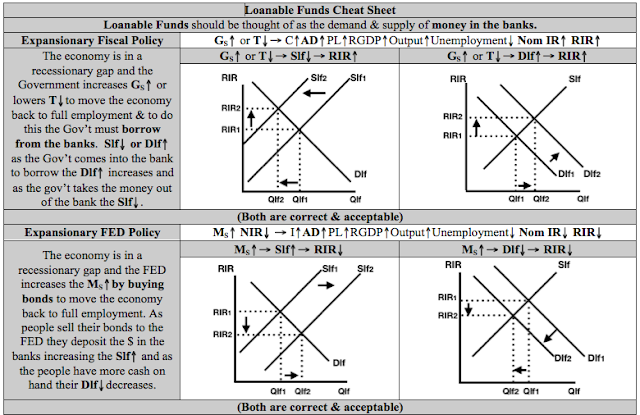2007 AP Micro FRQ#2 (Labor)
Wednesday, December 2, 2020
Tuesday, November 17, 2020
2005 AP Micro FRQ #3 (Factor Markets/Labor)
Watch me answer it here
a) In what kind of market structure does this firm sell its output? Look at the directions above,,, "The firm can sell all the shirts it can produce to retailers at the price of $20 dollars. Read it again,"The firm can sell all the shirts it can produce to retailers at the price of $20 dollars. Read it again,"The firm can sell all the shirts it can produce to retailers at the price of $20 dollars. Question - can a monopoly sell all the goods it wants at the same price,,, NO., it must lower its price to sell more.. Only a perfectly competitive (price taker) industry market could do this....
(Answer: Perfectly Competitive Market)
b) In what kind of market structure does this firm hire its workers? Again, look at the directions, "P & L can hire all of the workers it wants at a market wage rate of $120 per day per worker. Read it again, "P & L can hire all of the workers it wants at a market wage rate of $120 per day per worker." Read it again, "P & L can hire all of the workers it wants at a market wage rate of $120 per day per worker." (Answer: this is a Perfectly Competitive (price taker) labor market.)
The rest is self explanatory - use a chart!!!
Friday, September 11, 2020
Wednesday, September 9, 2020
Tuesday, September 8, 2020
Tuesday, September 1, 2020
Monday, August 31, 2020
Friday, August 28, 2020
Comparative Advantage (Input) Problem 1995 Step by Step
Comparative Advantage (Input) Problem 1995
1. Determine - if it an Output or Input problem?
2. Draw a Graph/PPC - of the problem.
3. Recognize - who has Absolute Advantage?
4. Compute - Comparative Advantage?
5. Redraw the Table - (if needed) with people/countries on the left and goods on the top.
6. Do the math - Input problem so the math is (Under).
7. Find/ Mark/Bubble in the right answer.
8. Dirty quick method - Cross Multiply after arranging the Table correctly and find the smaller number.
9. Go back and check - to make sure you did everything right
1995
Input questions have (1 unit of X) as what is produced, that can be (1 ton of wheat) or (one pair of shoes) or in this instance (1 unit of food) or (1 unit of clothing)
What are variable are the resources used in producing the (1 unit of food) .
Output problems - inputs/resources used in production of the good are (fixed/equal resources) the amount actually produced is (variable)
Lets say it a different way.
In the above question – Country X used 20 resources to produce (1 unit of food) while Country Y used 10 resources to produce (1 unit of food).
The resources used to produce are (different/variable) while what is produced is fixed (1 unit of food) so this is an Input Problem.
Lets say it a different way.
If what goes in is variable it's an Input problem
If what comes out is variable it's an Output problem
As it is an input problem Country Y is the most efficient and has absolute advantage in producing both Food and Clothing.
Lets say it as simply as possible:
If it’s an Output problem who ever produces the most has absolute advantage but if it’s an input problem who ever produces using the least resources has absolute advantage.
In this Input problem Country Y has absolute advantage in food and clothing as it can produce both goods using the least amount of resources.
4. Compute - Comparative Advantage?
7. Find/ Mark/Bubble in the right answer.
8. Dirty quick method - Cross Multiply after arranging the Table correctly and find the smaller number for an Input problem.
9. Go back and check - to make sure you did everything right
Comparative Advantage Output Problem (1990) Step by Step
Comparative Advantage Output Problem (1990)
1. Is it an Output or Input problem? (This is always the first question!)
How do we know this is an Output problem, the amount of production (output) is variable based on the productive ability between England & Portugal, while the resources that go into the production of the goods are fixed (unit of labor input).
Output problems - inputs/resources used in production of the good are (fixed/equal resources) the amount actually produced is (variable)
Input problems – inputs/resources used in production of the good is (variable) the amount actually produced is (fixed).
Lets say it a different way
Portugal using 1 unit of labor can produce 24 cloths while England using 1 unit of labor can produce 20 cloths respectively.
Both are using equal resources (1 unit of labor input) to produce but the Production or output of cloth is variable (England 20 compared to Portugal of 24).
Lets say it a different way
If what goes in is variable it's an Input problem
If what comes out is variable it's an Output problem
2. Draw a Graph/PPC of the problem.
Notice that since it is an Output problem Portugal can produce more of both goods compared to England.
3. Who has Absolute Advantage?
In this Output problem Portugal has an Absolute advantage in the production of both goods as it can produce more in comparison with England using equal resources.
4. Who has a comparative advantage?
5. Redraw the table (if needed) with people/countries on the left and goods on the top.
Super quick way to find
Comparative Advantage for Output Problems
8. Cross Multiply after arranging the Table correctly and find the larger number.
9. Go back and check to make sure you did everything right

























































